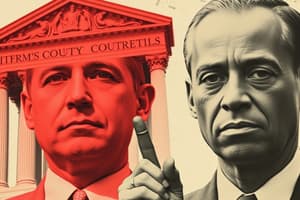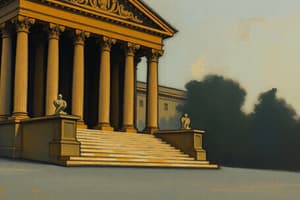Podcast
Questions and Answers
Which constitutional clause provided the basis for the implied power to establish a national bank?
Which constitutional clause provided the basis for the implied power to establish a national bank?
- The Supremacy Clause
- The Commerce Clause
- The Necessary and Proper Clause (correct)
- The Equal Protection Clause
In United States v. Lopez, what was the central argument against the Gun-Free School Zones Act of 1990?
In United States v. Lopez, what was the central argument against the Gun-Free School Zones Act of 1990?
- The act was discriminatory against students from low-income backgrounds.
- The act violated the Second Amendment rights of students.
- The act exceeded Congress's power under the Commerce Clause. (correct)
- The act infringed upon the states' rights to establish educational standards.
What was the Supreme Court's ruling in Citizens United v. FEC regarding the regulation of political spending by corporations and unions?
What was the Supreme Court's ruling in Citizens United v. FEC regarding the regulation of political spending by corporations and unions?
- The ruling upheld the McCain-Feingold Act's limitations on corporate political spending.
- Restrictions on political spending by corporations and unions were constitutional under the principle of campaign finance regulation.
- Such restrictions violated the First Amendment's guarantee of free speech. (correct)
- The FEC had the authority to regulate political spending to prevent corruption.
Considering the principles of federalism, how did United States v. Lopez impact the balance of power between the federal and state governments?
Considering the principles of federalism, how did United States v. Lopez impact the balance of power between the federal and state governments?
How did the Citizens United v. FEC ruling affect campaign finance laws in the United States?
How did the Citizens United v. FEC ruling affect campaign finance laws in the United States?
Which of the following scenarios would most likely be protected under the precedent set by Tinker v. Des Moines?
Which of the following scenarios would most likely be protected under the precedent set by Tinker v. Des Moines?
How did McDonald v. Chicago (2010) build upon the Supreme Court's previous ruling in Heller v. D.C.?
How did McDonald v. Chicago (2010) build upon the Supreme Court's previous ruling in Heller v. D.C.?
A state law requires all public schools to begin each day with a prayer, though students can opt out. Which Supreme Court case is most relevant to challenging this law, and on what grounds?
A state law requires all public schools to begin each day with a prayer, though students can opt out. Which Supreme Court case is most relevant to challenging this law, and on what grounds?
Which scenario is most likely to be considered unprotected speech based on the precedent set by Schenck v. United States?
Which scenario is most likely to be considered unprotected speech based on the precedent set by Schenck v. United States?
How does the concept of 'judicial review,' established in Marbury v. Madison, affect the balance of power in the U.S. government?
How does the concept of 'judicial review,' established in Marbury v. Madison, affect the balance of power in the U.S. government?
Wisconsin v. Yoder (1972) is a significant case regarding religious freedom. In what way did this ruling impact compulsory education laws?
Wisconsin v. Yoder (1972) is a significant case regarding religious freedom. In what way did this ruling impact compulsory education laws?
In New York Times v. United States (1971), the government argued that publishing the Pentagon Papers threatened national security. What legal principle did the Supreme Court prioritize in its decision against prior restraint?
In New York Times v. United States (1971), the government argued that publishing the Pentagon Papers threatened national security. What legal principle did the Supreme Court prioritize in its decision against prior restraint?
How does the ruling in Gideon v. Wainwright (1963) affect the rights of defendants in criminal trials?
How does the ruling in Gideon v. Wainwright (1963) affect the rights of defendants in criminal trials?
Flashcards
Establishing a Bank: Implied Power
Establishing a Bank: Implied Power
The power for the federal government to create a national bank, stemming from the Necessary and Proper Clause, linked to expressed powers.
State Taxation of National Bank
State Taxation of National Bank
States cannot tax the national bank, solidifying federal authority.
US v. Lopez: Commerce Clause
US v. Lopez: Commerce Clause
Congress exceeded its power under the Commerce Clause by enacting the Gun-Free School Zones Act, as guns in schools did not substantially affect interstate commerce.
Citizens United v. FEC
Citizens United v. FEC
Signup and view all the flashcards
Preliminary Injunction
Preliminary Injunction
Signup and view all the flashcards
Engel v. Vitale (1962)
Engel v. Vitale (1962)
Signup and view all the flashcards
Wisconsin v. Yoder (1972)
Wisconsin v. Yoder (1972)
Signup and view all the flashcards
Tinker v. Des Moines (1969)
Tinker v. Des Moines (1969)
Signup and view all the flashcards
New York Times v. United States (1971)
New York Times v. United States (1971)
Signup and view all the flashcards
Schenck v. United States (1919)
Schenck v. United States (1919)
Signup and view all the flashcards
Gideon v. Wainwright (1963)
Gideon v. Wainwright (1963)
Signup and view all the flashcards
McDonald v. Chicago (2010)
McDonald v. Chicago (2010)
Signup and view all the flashcards
Marbury v. Madison
Marbury v. Madison
Signup and view all the flashcards
Study Notes
- Landmark court cases established groundwork for future legal interpretations and applications.
Engel v. Vitale (1962)
- New York's practice of having a nondenominational prayer recited by students at school was challenged.
- Students had the option to opt out of the prayer.
- The Supreme Court ruled in favor of individual liberties.
- The ruling cited the Establishment Clause of the First Amendment.
- This case established a basis for future cases involving religion in schools.
Wisconsin v. Yoder (1972)
- Amish parents sought to discontinue sending their children to school after the 8th grade due to religious beliefs.
- The Supreme Court ruled in favor of Yoder, citing the Free Exercise Clause.
- The Court argued that the state's interest in education did not outweigh the right to religious practice.
- The ruling contributed to the growth of the homeschool movement.
Tinker v. Des Moines (1969)
- Students were suspended for wearing black armbands to school in protest of the Vietnam War.
- The Supreme Court ruled that the suspension violated the students' First Amendment rights.
- This case led to the creation of the Substantial Disruption Test, requiring schools to demonstrate potential disruptions to justify speech restrictions.
- It established a precedent for balancing free speech rights with maintaining a conflict-free school environment.
New York Times v. United States (1971)
- The Nixon administration attempted to halt the New York Times from publishing the Pentagon Papers, citing national security concerns.
- The Supreme Court ruled in favor of the New York Times, upholding freedom of the press.
- The Court established a high standard for prior restraint, allowing it only in cases of genuine national security threats.
- This ruling made it more challenging to censor the press.
Schenck v. United States (1919)
- Schenck, a socialist, was arrested under the Espionage Act for distributing pamphlets urging resistance to the WWI draft.
- The Supreme Court ruled that Schenck's First Amendment rights were not violated.
- The ruling was based on the "Clear and Present Danger" test.
Gideon v. Wainwright (1963)
- Gideon was arrested in Florida and, lacking a lawyer, had to represent himself and lost the case.
- The Supreme Court ruled that this violated the Sixth Amendment right to counsel.
- States are now required to provide legal representation to defendants who cannot afford it.
McDonald v. Chicago (2010)
- Following Heller v. D.C., which deemed restrictive gun laws unconstitutional in federal territories, McDonald challenged handgun laws in Chicago.
- The Supreme Court ruled in favor of McDonald, citing the Second Amendment.
- The Court emphasized personal liberty over public safety, leading states to revise their gun laws.
Marbury v. Madison
- Marbury's appointment as a justice was not completed before Adams left office, leading Marbury to sue Madison (Secretary of State).
- The Supreme Court established the principle of judicial review.
- The Court declared the law Marbury sought to challenge as unconstitutional.
- The impact of the ruling was the establishment of judicial review.
McCulloch v. Maryland
- Congress established the Second Bank of the United States, a national bank, leading Maryland to enact taxes on the bank.
- Bank officials resisted paying the tax, leading to a Supreme Court case.
- The Supreme Court determined that creating a national bank was an implied power under the Necessary and Proper Clause, which allowed the establishment of the bank as within its expressed powers.
- The Court also ruled that states cannot tax the federal bank.
US v. Lopez
- Lopez carried an unloaded gun and ammunition to school, intending to sell them.
- Initially charged under Texas law, he was then charged with violating the federal Gun-Free School Zones Act of 1990.
- Lopez argued that the act was unconstitutional, exceeding Congress's enumerated powers.
- Congress argued that the Commerce Clause allowed the regulation of firearms.
- The Supreme Court ruled that guns in schools did not relate to interstate commerce.
- The ruling was significant as defining all activities as commerce would undermine the power of state governments and increase the power of the national government.
Citizens United v. FEC
- The Supreme Court ruled that laws restricting the political spending of corporations and unions violated the First Amendment's right to free speech.
- This ruling significantly altered campaign finance laws.
Studying That Suits You
Use AI to generate personalized quizzes and flashcards to suit your learning preferences.




